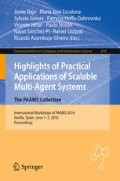Abstract
This paper presents the results of the project, which goal is to analyze the production process capability after reengineering the assembly process due to expansion of a bus production plant. The verification of the designed work organization for the new configuration of workstations on new production hall is necessary. The simulation model is the best tool for visualization and verification of the work organization based on individual workteams which are supporting particular workstations. Owing to the simulation it is possible to define the imperfections of this conception and elaborate improvements which will minimize the idleness of workers and downtime occurring in the assembly process. The objective of performed activities is to provide assurance that the new organization of assembly process will lead to maximum utilization of production capacity in the company. To solve described problems authors propose a method based on mixing DES (Discrete Event Simulation) and ABS (Agent Based Simulation) approach. DES was used to model the main process – material flow (buses), ABS was used to model assembling operations of teams of workers.
Access this chapter
Tax calculation will be finalised at checkout
Purchases are for personal use only
References
Allan, R.: Survey of agent based modeling and simulation tools. In: STFC 2008–2009, pp. 1–28 (2009)
Bartkowiak, T., Gessner, A.: Modeling performance of a production line and optimizing its efficiency by means of genetic algorithm. In: ASME 2014 12th Biennial Conference on Engineering Systems Design and Analysis - Volume 3: Engineering Systems; Heat Transfer and Thermal Engineering; Materials and Tribology; Mechatronics; Robotics Copenhagen, Denmark (2014)
Beaverstock, M., Greenwood, A., Lavery, E., Nordgren, W.: Applied Simulation: Modeling and Analysis Using Flexsim. Flexsim Software Products, Inc., Canyon Park Technology Center, Orem, USA (2011)
Bozarth, C., Handfield, R.B.: Introduction to Operations and Supply Chain Management, 3rd edn. Prentice Hall, Upper Saddle River (2012)
Cox, J.F., Blackstone, J.H.: APICS Dictionary, Alexandria, VA, APICS (2002)
Hammer, M., Champy, J.: Reengineering the Corporation: A Manifesto for Business Revolution. HarperBusiness (1993)
Jasiulewicz-Kaczmarek, M., Drożyner, P.: Maintenance management initiatives towards achieving sustainable development. In: Golinska, P., et al. (eds.) Information Technologies in Environmental Engineering Environmental Science and Engineering, pp. 707–721. Springer, Berlin (2011)
Korytkowski, P., Karkoszka, R.: Simulation based efficiency analysis of an in-plant milk-run operator under disturbances. Int. J. Adv. Manuf. Technol. 82(5), 827–837 (2016)
Macal, Ch.M., North, M.J.: Agent-based modeling and simulation: desktop ABMS. In: Henderson, S.G., Biller, B., Hsieh, M.H., Shortle, J., Tew, D.J., Barton, R.R. (eds) Proceedings of the 2007 Winter Simulation Conference
Pawlewski, P.: DES/ABS approach to simulate warehouse operations. In: Bajo, J., Hallenborg, K., Pawlewski, P., Botti, V., Sánchez-Pi, N., Duque Méndez, N.D., Lopes, F., Vicente, J. (eds.) PAAMS 2015 Workshops. CCIS, vol. 524, pp. 115–125. Springer, Heidelberg (2015)
Scholl, A., Becker, C.: A survey on problems and methods in generalized assembly line balancing. Eur. J. Oper. Res. 168(3), 694–715 (2003)
Siebers, P.O., Macal, C.M., Garnett, J., Buxton, D., Pidd, M.: Discrete-event simulation is dead, long live agent-based simulation! J. Simul. 4(3), 204–210 (2010)
Zemczak, M.: Zagadnienie balansowania linii montażowej i szeregowania zadań w systemach produkcji mixed-model. Informatyczne systemy zarządzania: tom 4: (Wybrane zastosowania)/red. nauk. Marcin Relich., Wydawnictwo Uczelniane Politechniki Koszalińskiej (2013)
Acknowledgement
Presented research works are carried out under the project – status activities of Faculty o Engineering Management DS 2016 Poznan University of Technology.
Author information
Authors and Affiliations
Corresponding author
Editor information
Editors and Affiliations
Rights and permissions
Copyright information
© 2016 Springer International Publishing Switzerland
About this paper
Cite this paper
Pawlewski, P., Kluska, K. (2016). Using DES/ABS Approach to Model and Simulate Bus Assembling Process. In: Bajo, J., et al. Highlights of Practical Applications of Scalable Multi-Agent Systems. The PAAMS Collection. PAAMS 2016. Communications in Computer and Information Science, vol 616. Springer, Cham. https://doi.org/10.1007/978-3-319-39387-2_10
Download citation
DOI: https://doi.org/10.1007/978-3-319-39387-2_10
Published:
Publisher Name: Springer, Cham
Print ISBN: 978-3-319-39386-5
Online ISBN: 978-3-319-39387-2
eBook Packages: Computer ScienceComputer Science (R0)

